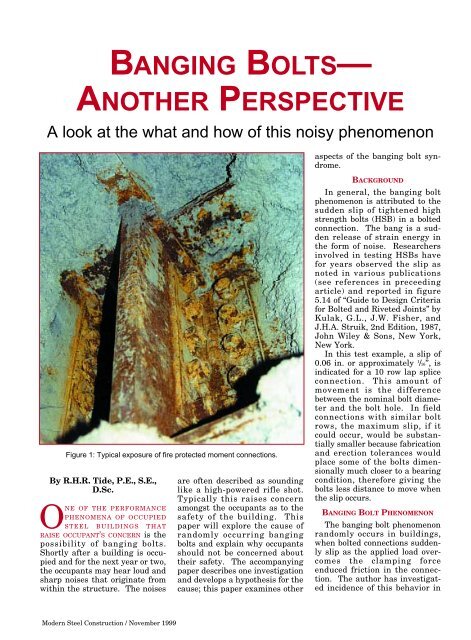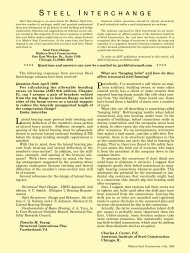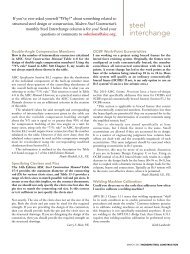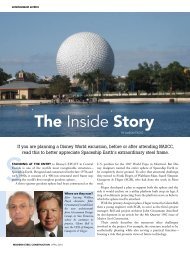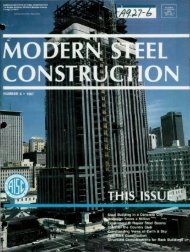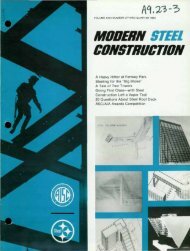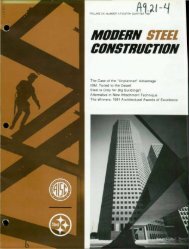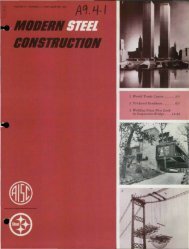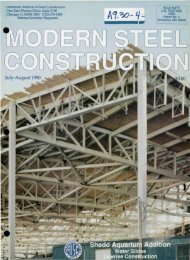banging bolts— another perspective - Modern Steel Construction
banging bolts— another perspective - Modern Steel Construction
banging bolts— another perspective - Modern Steel Construction
Create successful ePaper yourself
Turn your PDF publications into a flip-book with our unique Google optimized e-Paper software.
BANGING BOLTS—<br />
ANOTHER PERSPECTIVE<br />
A look at the what and how of this noisy phenomenon<br />
Figure 1: Typical exposure of fire protected moment connections.<br />
By R.H.R. Tide, P.E., S.E.,<br />
D.Sc.<br />
ONE OF THE PERFORMANCE<br />
PHENOMENA OF OCCUPIED<br />
STEEL BUILDINGS THAT<br />
RAISE OCCUPANT’S CONCERN is the<br />
possibility of <strong>banging</strong> bolts.<br />
Shortly after a building is occupied<br />
and for the next year or two,<br />
the occupants may hear loud and<br />
sharp noises that originate from<br />
within the structure. The noises<br />
<strong>Modern</strong> <strong>Steel</strong> <strong>Construction</strong> / November 1999<br />
are often described as sounding<br />
like a high-powered rifle shot.<br />
Typically this raises concern<br />
amongst the occupants as to the<br />
safety of the building. This<br />
paper will explore the cause of<br />
randomly occurring <strong>banging</strong><br />
bolts and explain why occupants<br />
should not be concerned about<br />
their safety. The accompanying<br />
paper describes one investigation<br />
and develops a hypothesis for the<br />
cause; this paper examines other<br />
aspects of the <strong>banging</strong> bolt syndrome.<br />
BACKGROUND<br />
In general, the <strong>banging</strong> bolt<br />
phenomenon is attributed to the<br />
sudden slip of tightened high<br />
strength bolts (HSB) in a bolted<br />
connection. The bang is a sudden<br />
release of strain energy in<br />
the form of noise. Researchers<br />
involved in testing HSBs have<br />
for years observed the slip as<br />
noted in various publications<br />
(see references in preceeding<br />
article) and reported in figure<br />
5.14 of “Guide to Design Criteria<br />
for Bolted and Riveted Joints” by<br />
Kulak, G.L., J.W. Fisher, and<br />
J.H.A. Struik, 2nd Edition, 1987,<br />
John Wiley & Sons, New York,<br />
New York.<br />
In this test example, a slip of<br />
0.06 in. or approximately 1 /16”, is<br />
indicated for a 10 row lap splice<br />
connection. This amount of<br />
movement is the difference<br />
between the nominal bolt diameter<br />
and the bolt hole. In field<br />
connections with similar bolt<br />
rows, the maximum slip, if it<br />
could occur, would be substantially<br />
smaller because fabrication<br />
and erection tolerances would<br />
place some of the bolts dimensionally<br />
much closer to a bearing<br />
condition, therefore giving the<br />
bolts less distance to move when<br />
the slip occurs.<br />
BANGING BOLT PHENOMENON<br />
The <strong>banging</strong> bolt phenomenon<br />
randomly occurs in buildings,<br />
when bolted connections suddenly<br />
slip as the applied load overcomes<br />
the clamping force<br />
enduced friction in the connection.<br />
The author has investigated<br />
incidence of this behavior in
uilding connections that can be<br />
divided into fundamentally three<br />
categories. The first category is<br />
a multi-bolt shear connection<br />
similar to the one described by<br />
Robert Schwein in the previous<br />
article where the beams support<br />
a composite metal floor system.<br />
The second category is the multibolt<br />
shear connection in industrial<br />
buildings without a floor system.<br />
The third category is a<br />
moment connection with multibolt<br />
web shear connection and<br />
welded beam flanges.<br />
In several projects where the<br />
<strong>banging</strong> noise was reported,<br />
investigations were performed to<br />
find actual connection movement.<br />
It was observed that the<br />
sprayed on fire protection corroded<br />
the surface of the beam web<br />
and shear tab as shown in Fig. 1.<br />
Removal of the fire protection<br />
and corroded mill scale obliterated<br />
any evidence of joint movement<br />
having a magnitude of only<br />
a couple of hundredths of an<br />
inch. Subsequent wire brushing<br />
as shown in Fig. 2 further hindered<br />
detection of any joint<br />
movement but allowed examination<br />
of the joint to verify that<br />
weld fractures had not occurred.<br />
The randomness of this phenomenon<br />
occurs because no sudden<br />
slip with the resultant<br />
“bang” will occur as long as any<br />
of the bolts in the connection<br />
group are already in bearing in<br />
the direction of the force. In<br />
steel framed buildings, the gravity<br />
weight typically pulls the supported<br />
members down so that<br />
one or more bolts will be in bearing.<br />
As a result, most buildings,<br />
each with hundreds of connections,<br />
will not experience the<br />
<strong>banging</strong> bolt phenomenon.<br />
However, whenever the erection<br />
procedure results in bolts that<br />
are nearly centered in the holes<br />
when tightened, such as employing<br />
drift pins, or other erection<br />
conditions the <strong>banging</strong> bolt phenomenon<br />
may occur. Ironically,<br />
as snug-tight bolts, slotted holes<br />
and shear tab usage became<br />
more prevalent, the incidence of<br />
<strong>banging</strong> bolts appears to have<br />
increased. The absence of paint<br />
Figure 2: Complete removal of fire pretection at edge of bolted connection.<br />
on steel is also considered a variable<br />
that has increased the<br />
occurrence of <strong>banging</strong> bolts. As<br />
reported by P.C. Birkemoe, paint<br />
allows the connection to gradually<br />
slip into bearing without the<br />
resulting noise (“High Strength<br />
Bolting: Recent Research and<br />
Design Practice.” Proceedings of<br />
W.H. Munse Symposium on<br />
Behavior of <strong>Steel</strong> Structures—<br />
Research to Practice, 1983, W.J.<br />
Hall and M.P. Gaus, Editors,<br />
ASCE, New York, New York.)<br />
CONNECTION FORCES<br />
The connection geometry that<br />
results in bolts located centrally<br />
in their respective bolt holes so<br />
that slip can occur is one of the<br />
contributing variables to <strong>banging</strong><br />
bolts. The other critical variable<br />
is the force that causes the<br />
bolts to slip. Actually, a force<br />
exists in nearly every connection.<br />
The preceeding article by<br />
Schwein has identified concrete<br />
slab shrinkage as one of the possible<br />
causes of forces that induce<br />
slip in the connections of steel<br />
framed structures.<br />
Another possibility is the timing<br />
of steel beam erection, the<br />
metal deck installation and<br />
pouring of the concrete slab. At<br />
each step the steel beam and the<br />
connection at each end will be at<br />
some base temperature.<br />
Subsequently, as the fire protec-<br />
tion is applied and the building<br />
is enclosed, whether the building<br />
is heated or cooled to a stable<br />
temperature of approximately 70<br />
degrees F may result in a temperature<br />
differential. The temperature<br />
differential magnitude<br />
from the time of bolt installation<br />
and tightening to enclosed building<br />
temperature is then a randomly<br />
occurring variable. A<br />
temperature differential of 20<br />
degrees F or slightly higher is<br />
not unreasonable. For welded<br />
moment connections with bolted<br />
webs, flange weld shrinkage is<br />
<strong>another</strong> possible driving force<br />
source. Finally, as the building<br />
is occupied, the live load increases<br />
within the first few months<br />
and may become the triggering<br />
condition that causes a few connections<br />
to bang.<br />
The force due to the temperature<br />
differential can be calculated<br />
from the basic thermal force<br />
condition if it is assumed that<br />
the columns at each end of a<br />
beam and the floors above and<br />
below provide a relatively high<br />
degree of restraint, yet <strong>another</strong><br />
random variable. The axial<br />
stress in a beam for a temperature<br />
change when the framing at<br />
each end is assumed to fully<br />
restrained is given by:<br />
where:<br />
f a = Eα ∆T<br />
<strong>Modern</strong> <strong>Steel</strong> <strong>Construction</strong> / November 1999
f a = axial stress, psi<br />
E = modulus of elasticity, 29 x<br />
(10) 6 , psi<br />
α = coefficient of thermal<br />
expansion, 6.5 x (10) -6 ,<br />
in/in/°F<br />
∆T = temperature differential, °F<br />
The appropriateness in considering<br />
thermal shrinkage as a<br />
cause of the bangs can be demonstrated<br />
by a simple example calculation.<br />
A W24x55 beam is<br />
framed into shear tabs that are<br />
welded to columns at each end.<br />
The beam web is attached to the<br />
shear tabs with five ASTM A325<br />
7 /8”-diameter bolts. The beam<br />
area is 16.2 sq. in. Assume a 20<br />
degree F drop in temperature<br />
from the time of bolt installation<br />
to occupancy.<br />
The axial stress is computed<br />
as 3.77 ksi corresponding to a<br />
beam axial force of 61.1 kip.<br />
Assume that the bolts have been<br />
pre-tensioned to the specified<br />
force of 39 kip and that the faying<br />
surfaces having a coefficient<br />
of friction of 0.3. Therefore, for<br />
the 5 bolts, the frictional force is<br />
58.5 kip which is approximately<br />
equal to the thermally induced<br />
force. Based on the stated<br />
assumptions slip is possible if<br />
there are no bolts in bearing.<br />
The effect of the live load can be<br />
accommodated in the example by<br />
slightly changing one of the variables.<br />
In moment connections, transverse<br />
shrinkage across the weld<br />
can be estimated using the AWS<br />
equation (AWS, “Welding<br />
Handbook”, Volume 1, 8th<br />
Edition, 1991, American Welding<br />
Society, Miami):<br />
S = 0.2A w /t + 0.05R<br />
where:<br />
S = transverse weld shrinkage, in.<br />
A w = cross sectional area of weld, in 2 .<br />
t = thickness of flange plate, in.<br />
R = root opening, in.<br />
Appropriate assumptions for<br />
the variables in this equation<br />
and for axial displacement<br />
(∆=PL/AE) will show that weld<br />
shrinkage can also result in a<br />
force that exceeds the friction<br />
force developed by the HSB<br />
<strong>Modern</strong> <strong>Steel</strong> <strong>Construction</strong> / November 1999<br />
clamping force.<br />
Schwein also raises some project<br />
specific issues that should be<br />
considered in the context of other<br />
investigations. The beam compressive<br />
force is attributed to differential<br />
shrinkage in the concrete<br />
slab due to variations in<br />
water/cement ratios. During<br />
other investigations, cracking<br />
has been observed in slabs along<br />
the girder lines and hairline<br />
cracking has also been observed<br />
at other locations, both of which<br />
could relieve beam compressive<br />
forces.<br />
Similarly, in only one direction<br />
the metal deck could resist<br />
the concrete shrinkage forces.<br />
Petrographic examinations of the<br />
concrete in the suspect and adjacent<br />
slabs could predict the<br />
water/cement ratio and the related<br />
differential shrinkage potential<br />
accurately enough to isolate<br />
the floor <strong>banging</strong> locations.<br />
Obtaining accurate temperature<br />
and cloud cover records floor-byfloor<br />
throughout the construction<br />
sequence would allow one to estimate<br />
the temperature differential<br />
conditions. It is unlikely<br />
that the actual floor-by-floor<br />
erection fit-up conditions would<br />
be documented. Therefore knowing<br />
the temperature differential<br />
between the time of erection and<br />
the time of building occupancy<br />
only allows a qualitative evaluation<br />
of the induced thermal<br />
forces. Knowledge of slab cracking<br />
patterns, water/cement<br />
ratios and temperature ranges<br />
etc. would facilitate a more indepth<br />
evaluation.<br />
The bolt installation procedure<br />
is <strong>another</strong> contributing factor.<br />
However, contrary to C.J.<br />
Carter (“What are ‘<strong>banging</strong> bolts’<br />
and how do they affect structural<br />
steel framing?”, <strong>Steel</strong><br />
Interchange, <strong>Modern</strong> <strong>Steel</strong><br />
<strong>Construction</strong>, Vol. 39, No. 7,<br />
July, 1999)), whether the bolts<br />
are installed to a snug-tight condition<br />
or a prescribed pre-tension<br />
for a slip-critical connection is<br />
not significant in the occurrence<br />
of the <strong>banging</strong> bolt phenomenon.<br />
For ¾”- and 7 /8”-diameter HSB<br />
properly installed by the cali-<br />
brated wrench, turn-of-nut, tension<br />
control (TC) or load indicator<br />
method, the snug-tight condition<br />
typically results in bolt<br />
tensions close enough to the prescribed<br />
pre-tension for slip-critical<br />
connections. As a result, slip<br />
under thermal conditions and<br />
service loads will be a random<br />
occurrence independent of the<br />
installation technique.<br />
Loosening connection bolts to<br />
induce <strong>banging</strong> bolts was an<br />
excellent concept that allowed<br />
Schwein to confirm the overall<br />
<strong>banging</strong> bolt hypothesis.<br />
SUMMARY & CONCLUSION<br />
The reported occurrence of<br />
<strong>banging</strong> bolts has become more<br />
frequent in recent years. The<br />
bang occurs when high strength<br />
bolts (HSB) slip into bearing<br />
with the release of strain energy<br />
in the form of noise. Because it<br />
occurs so randomly in relatively<br />
few steel framed buildings constructed<br />
each year and for only a<br />
small percentage of the connections<br />
in those buildings, specific<br />
data is not readily available.<br />
The randomness can be attributed<br />
to fabrication/erection tolerances<br />
that for the most part<br />
result in HSB bearing conditions<br />
which prevents HSB slippage.<br />
The increase in <strong>banging</strong> bolts<br />
incidents also coincides with the<br />
increase in use of single plate<br />
shear tabs and slotted holes, a<br />
connection configuration that is<br />
likely to have all bolts in a nonbearing<br />
condition in the horizontal<br />
direction. The decrease in<br />
the use of painted steel members<br />
also contributes to the increase<br />
in sudden slippage.<br />
Driving forces causing the<br />
<strong>banging</strong> bolt phenomenon can be<br />
attributed to concrete floor slab<br />
shrinkage, differential temperature<br />
conditions between the time<br />
of bolt tightening and building<br />
enclosure, and weld shrinkage in<br />
moment connections. Erection<br />
conditions that require forced<br />
alignment of steel members can<br />
also act as a driving force. The<br />
subsequent live load that results<br />
from building occupancy within<br />
the first few months to a year or
so is the triggering force that<br />
causes the slip and resulting<br />
bang. It is probable that the differential<br />
temperature condition<br />
is the primary driving force<br />
because <strong>banging</strong> bolts have been<br />
heard in buildings without concrete<br />
slabs. In one instance, an<br />
industrial building with welded<br />
connections and without a concrete<br />
slab also experienced the<br />
<strong>banging</strong> bolt phenomenon.<br />
In conclusion, as the accompanying<br />
article also indicates, the<br />
<strong>banging</strong> bolt phenomenon is an<br />
indication that a steel framed<br />
building is reaching its final<br />
equilibrium position but the<br />
<strong>banging</strong> is not of any concern<br />
regarding design or safety<br />
issues.<br />
R.H.R. Tide, P.E., S.E., D.Sc.,<br />
is a Senior Consultant, Wiss,<br />
Janney, Elstner Associates, Inc.,<br />
Northbrook, IL and also a member<br />
and chair of subcommittees<br />
on high strength bolts for both<br />
AISC and RCSC Committees.<br />
<strong>Modern</strong> <strong>Steel</strong> <strong>Construction</strong> / November 1999


